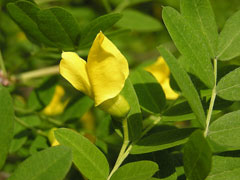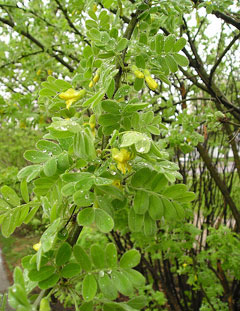 |
|
http://www.flickr.com/photos/54193473@N00 |
 |
| http://commons.wikimedia.org/wiki/User:Butko |
Translate this page:
Summary
C. arborescensis is a medium to fast growing perennial shrub. A species of legume. Leaves are alternate and compound with small leaflets and can be light to dark green. Small, yellow fragrant flowers bloom in early summer with pod fruits, containing many seeds, ripening in mid summer. Both the seed and seed pods are edible. Medicinal Uses include: Cancer; Emmenagogue. Other uses include: Dye; Fibre; Hedge; Oil; Shelterbelt; Soil stabilization; Hedge.
Physical Characteristics

 Caragana arborescens is a deciduous Shrub growing to 6 m (19ft) by 4 m (13ft) at a fast rate.
Caragana arborescens is a deciduous Shrub growing to 6 m (19ft) by 4 m (13ft) at a fast rate.
See above for USDA hardiness. It is hardy to UK zone 2 and is not frost tender. It is in flower in May, and the seeds ripen in September. The species is hermaphrodite (has both male and female organs) and is pollinated by Bees. The plant is self-fertile.
It can fix Nitrogen.
It is noted for attracting wildlife.
Suitable for: light (sandy) and medium (loamy) soils, prefers well-drained soil and can grow in nutritionally poor soil. Suitable pH: mildly acid, neutral and basic (mildly alkaline) soils and can grow in very alkaline soils.
It cannot grow in the shade. It prefers dry or moist soil and can tolerate drought. The plant can tolerates strong winds but not maritime exposure.
UK Hardiness Map
US Hardiness Map
Synonyms
Plant Habitats
Woodland Garden Sunny Edge; Hedge;
Edible Uses
Edible Parts: Oil Seed Seedpod
Edible Uses: Oil
Seed - cooked[2, 105]. Small but produced in abundance[11], there are 4 - 6 seeds per pod[202]. A bland flavour, it is best used in spicy dishes[183]. The raw seed has a mild pea-like flavour, though we are not sure if it should be eaten in quantity when raw[K]. The seed contains 12.4% of a fatty oil and up to 36% protein[183, 269], it has been recommended as an emergency food for humans[65]. More than just an emergency food, this species has the potential to become a staple crop in areas with continental climates[K]. Young pods - cooked and used as a vegetable[46, 61, 105, 177, 183, 269].
References More on Edible Uses
Medicinal Uses
Plants For A Future can not take any responsibility for any adverse effects from the use of plants. Always seek advice from a professional before using a plant medicinally.
Cancer Emmenagogue
The whole plant, known as ning tiao, is used in the treatment of cancer of the breast, and the orifice to the womb, and for dysmenorrhoea and other gynaecological problems[269].
References More on Medicinal Uses
The Bookshop: Edible Plant Books
Our Latest books on Perennial Plants For Food Forests and Permaculture Gardens in paperback or digital formats.

Edible Tropical Plants
Food Forest Plants for Hotter Conditions: 250+ Plants For Tropical Food Forests & Permaculture Gardens.
More

Edible Temperate Plants
Plants for Your Food Forest: 500 Plants for Temperate Food Forests & Permaculture Gardens.
More

More Books
PFAF have eight books available in paperback and digital formats. Browse the shop for more information.
Shop Now
Other Uses
Companion Dye Fibre Hedge Hedge Oil Shelterbelt Soil stabilization
A fibre obtained from the bark is used for making cordage[46, 61, 74, 269]. A blue dye is obtained from the leaves[74, 269]. The seed contains 12.4% of a fatty oil[74]. The plant can be grown as a hedge[160]. It is quite wind-resistant and can also be planted in a shelterbelt[200]. The plant has an extensive root system and can be used for erosion control, especially on marginal land[160]. Because of its nitrogen-fixing capacity, it is valued as a soil-improving plant[269]. 1. Nectary - Flowers rich in nectar and pollen:
Yes – Caragana species produce flowers that are rich in nectar and pollen, attracting bees and other pollinators.
2. Wildlife - Food (Fruit, Seeds, Leaf litter, Shelter, Nesting, Roosting):
Yes, the seeds and pods of Caragana species can provide food for birds and small mammals. The dense shrub structure offers shelter, nesting, and roosting sites for birds and insects.
3. Invertebrate Shelter (Overwintering sites, Leaf litter, Groundcover):
Yes – Caragana’s dense growth can provide shelter for invertebrates, and its leaf litter can create overwintering sites for beneficial insects.
4. Pest Confuser (Smell):
No – Caragana species do not have a strong scent that would act as a pest confuser.
Special Uses
Attracts Wildlife Carbon Farming Food Forest Hedge Hedge Nitrogen Fixer
References More on Other Uses
Cultivation details
Agroforestry Services: Living fence Agroforestry Services: Nitrogen Agroforestry Services: Windbreak Industrial Crop: Biomass Management: Coppice Management: Standard Minor Global Crop Staple Crop: Protein
Succeeds in most well-drained soils, preferring full sun and a light sandy dry or well-drained soil[1, 11, 200]. Tolerates very alkaline soils[202]. Plants do not require a rich soil[1, 11, 108], succeeding on marginal land[160]. Established plants are drought resistant[160]. Fast growing[188]. Dormant plants are hardy to about -30°c[184], they prefer a continental climate and do not grow so well in areas that do not have very cold winters[200]. They grow and fruit very well in the eastern half of the country, even in northern areas, though they do not do so well in the wetter west[K]. The young growth in spring, even on mature plants, is frost-tender and so it is best to grow the plants in a position sheltered from the early morning sun[K]. The Siberian pea shrub has an excellent potential to become a staple food crop. The seed is nutritious and wholesome, although rather small it is often very freely borne and is easily harvested[K]. This species has also been recommended as a nitrogen-fixing windbreak and ground cover plant that binds the soil and produces fibre and dye stuffs[218]. C. boisii and C. fruticosa are closely related to this species[182] and can probably be used similarly[K]. A very ornamental plant, some named forms have been developed for their ornamental value[182]. 'Nana' is a very compact dwarf form[183] that grows slowly[11]. 'Pendula' has stiffly pendent branches but is otherwise the same as the type species[11]. A good bee plant[74]. Plants in this genus are notably resistant to honey fungus[200]. This species has a symbiotic relationship with certain soil bacteria, these bacteria form nodules on the roots and fix atmospheric nitrogen. Some of this nitrogen is utilized by the growing plant but some can also be used by other plants growing nearby[200]. The plant is heat tolerant in zones 8 through 1. (Plant Hardiness Zones show how well plants withstand cold winter temperatures.
Plant Heat Zones show when plants would start suffering from the heat.
The Plant Heat Zone map is based on the number of "heat days" experienced in a given area where the temperature climbs to over 86 degrees F (30°C).
At this temperature, many plants begin to suffer physiological damage. Heat Zones range from 1 (no heat days) to 12 (210 or more heat days).
For example Heat Zone. 11-1 indicates that the plant is heat tolerant in zones 11 through 1.) For polyculture design as well as the above-ground architecture (form - tree, shrub etc. and size shown above) information on the habit and root pattern is also useful and given here if available. The plant growth habit is multistemmed with multiple stems from the crown [1-2].
Carbon Farming
-
Agroforestry Services: Living fence
Simply managed rows of shrubs and trees.
-
Agroforestry Services: Nitrogen
Plants that contribute to nitrogen fixation include the legume family – Fabaceae.
-
Agroforestry Services: Windbreak
Linear plantings of trees and shrubs designed to enhance crop production, protect people and livestock and benefit soil and water conservation.
-
Industrial Crop: Biomass
Three broad categories: bamboos, resprouting woody plants, and giant grasses. uses include: protein, materials (paper, building materials, fibers, biochar etc.), chemicals (biobased chemicals), energy - biofuels
-
Management: Coppice
Cut to the ground repeatedly - resprouting vigorously. Non-destructive management systems maintaining the soil organic carbon.
-
Management: Standard
Plants grow to their standard height. Harvest fruit, seeds, or other products. Non-Destructive management systems.
-
Minor Global Crop
These crops are already grown or traded around the world, but on a smaller scale than the global perennial staple and industrial crops, The annual value of a minor global crop is under $1 billion US. Examples include shea, carob, Brazil nuts and fibers such as ramie and sisal.
-
Staple Crop: Protein
(16+ percent protein, 0-15 percent oil). Annuals include beans, chickpeas, lentils, cowpeas, and pigeon peas. Perennials include perennial beans, nuts, leaf protein concentrates, and edible milks.
References Carbon Farming Information and Carbon Sequestration Information
Temperature Converter
Type a value in the Celsius field to convert the value to Fahrenheit:
Fahrenheit:
The PFAF Bookshop
Plants For A Future have a number of books available in paperback and digital form. Book titles include Edible Plants, Edible Perennials, Edible Trees,Edible Shrubs, Woodland Gardening, and Temperate Food Forest Plants. Our new book is Food Forest Plants For Hotter Conditions (Tropical and Sub-Tropical).
Shop Now
Plant Propagation
Seed - best sown as soon as it is ripe in a cold frame[200]. It usually germinates in 2 weeks[K]. Stored seed should be pre-soaked for 24 hours in warm water then sown in a cold frame[78, 113, 200]. If the seed has not swollen then scarify it and re-soak for another 12 hours before sowing[138]. Germination usually takes place within 2 - 3 weeks at 20°c[138]. Good percentage[11]. As soon as they are large enough to handle, prick the seedlings out into individual pots and grow them on in a greenhouse for at least their first winter. Plant them out into their permanent positions in late spring or early summer, after the last expected frosts. There are approximately 40,000 seeds per kilo[269]. Cuttings of half-ripe wood, 7 - 10cm with a heel, July/August in a frame[113]. Layering in spring.
Other Names
If available other names are mentioned here
Black karagana, Shu Jinjier, Tree Caragana,
Native Range
TEMPERATE ASIA: Altay, Buryatia, China, Gansu Sheng (east), Gorno-Altay, Hakasija, Hebei Sheng, Heilongjiang Sheng, Irkutsk, Kazakhstan (east), Kemerovskaja oblast, Krasnoyarsk, Kyrgyzstan, Mongolia (north), Nei Mongol Zizhiqu (northeast), Novosibirsk, Respublika, Respublika, Shaanxi Sheng, Shanxi Sheng, Tomsk, Tyva, Xinjiang Uygur Zizhiqu (north), Yakutia-Sakha,Russian Federation.
Weed Potential
Right plant wrong place. We are currently updating this section.
Please note that a plant may be invasive in one area but may not in your area so it's worth checking.
Conservation Status
IUCN Red List of Threatened Plants Status :

Growth: S = slow M = medium F = fast. Soil: L = light (sandy) M = medium H = heavy (clay). pH: A = acid N = neutral B = basic (alkaline). Shade: F = full shade S = semi-shade N = no shade. Moisture: D = dry M = Moist We = wet Wa = water.
Now available:
Food Forest Plants for Mediterranean Conditions
350+ Perennial Plants For Mediterranean and Drier Food Forests and Permaculture Gardens.
[Paperback and eBook]
This is the third in Plants For A Future's series of plant guides for food forests tailored to
specific climate zones. Following volumes on temperate and tropical ecosystems, this book focuses
on species suited to Mediterranean conditions—regions with hot, dry summers and cool, wet winters,
often facing the added challenge of climate change.
Read More
Expert comment
Author
Lam.
Botanical References
1174200
Links / References
For a list of references used on this page please go here
Readers comment